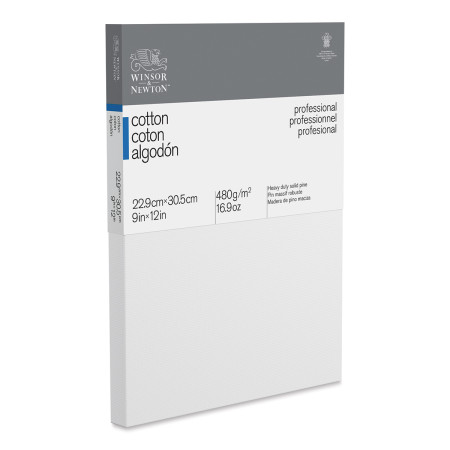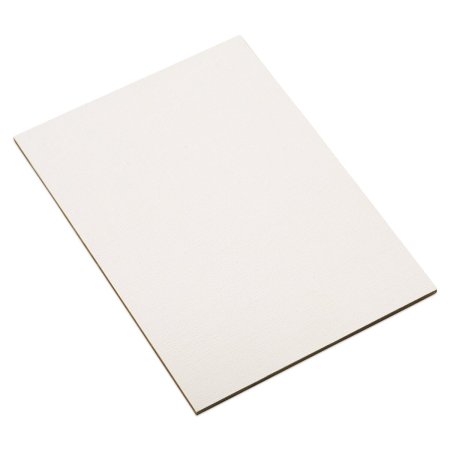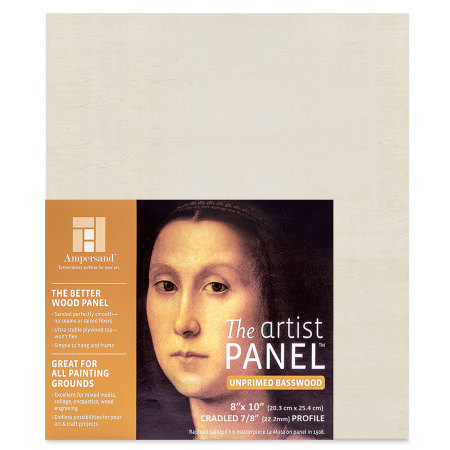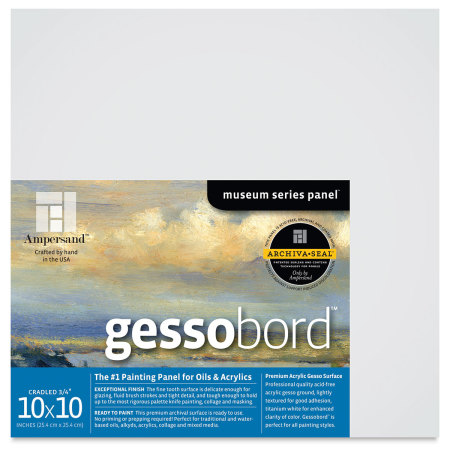The best surfaces for acrylic painting should have ‘tooth’. This means is that it should have a surface texture that the paint can bind to. The ‘tooth’ is like the grain of the canvas, or wood. If you choose a surface that has no tooth, like glass, then the acrylic will stick, but it will be removable by peeling or scraping the paint off.
However, finding surfaces for acrylic painting isn’t a difficult task—paint can adhere to many different supports. There’s a wide range of ready made and primed surfaces available to artists.
In this guide, discover the different surfaces available to acrylic painters, the brands that are most loved by professional artists and find the best option for you.
Disclaimer: Fine Art Tutorials is a reader supported site. When you make purchases through links on this site, we may earn a small commission at no extra cost to you.
Paper
Acrylic paper is a brilliant and economical option for acrylic painting. It’s especially suitable if you like to thin the paint with lots of water. This is because paper is the most absorbent surface. Also, you usually paint on paper flat on a table, rather than supported upright on an easel, so the low viscosity acrylic won’t run.
You can use acrylic on any kind of paper, but thick paper is best. That is paper that has a weight of 290g/m² or higher. Heavier paper is more absorbent (useful if you thin paints with water or medium), is more rigid and less prone to breaking.
The best paper for acrylic painting is paper that has been specially designed for the job. High quality papers will be acid-free and archival quality. This means that they won’t yellow or break down over time. If you frame your artwork then expect it to last decades.
TIP: If you want a clean, straight border around your artwork get some low tack masking tape and stretch it around the edges of the acrylic painting paper. Then simply paint on top and peel away when it’s dry.
Our product picks
Clairefontaine: Acrylic Pad 360g/m²
10 sheets of heavy acid-free 360g/m² painting paper in A3 or A4. The paper has been specially designed to give support to acrylic colours.
Canson: Oil and Acrylic Pad 290g/m²
10 sheets of acid-free 290g/m² painting paper 9×13″. The paper is great value and has a canvas texture. It is ready to use with acrylic paint.
Canvas
Canvases can be bought stretched in two different fabrics, cotton and linen. Most canvases you buy online and in art stores come pre-stretched and pre-primed with gesso. Many artists opt to buy these as it is more convenient than doing it yourself. However, if you want to learn how to stretch your own canvas, check out our guide.
So what are the differences between the two fabrics?
Cotton
If you’re working on a small to medium scale and you don’t mind your painting surface having a bit of texture to it, it’s relatively inexpensive to buy pre-primed pre-stretched cotton canvases and dive into painting on them straight away.
Cotton canvases are more economical than linen, but the surface is more flexible. This makes it less ideal for painting larger pieces. If you are working on a large scale painting with cotton, problems may arise, such as finding dips in the middle of the canvas where the fabric isn’t taut enough, or the surface generally not feeling rigid enough for painting. For this reason, I recommend using linen for large artworks.
The weave of a cotton canvas is prominent. It’s possible to smooth this grain, to an eggshell finish that is much more suitable for detailed work. To create this effect, apply gesso to the surface
If you don’t smooth the surface with gesso, I recommend using bristle brushes or a synthetic alternative. With these, you can easily work heavy body paint into the weave of the canvas.
Our product picks
Winsor & Newton: Professional Cotton Canvas

Archival cotton canvas hand stretched over solid kiln dried pine stretcher bars. The cotton is of superior thickness and the surface tension is excellent. The canvas has been primed with highly pigmented white gesso.
Loxley: Traditional Cotton Canvas
A more wallet friendly option, Loxley cotton canvases come in a range of sizes. They are sized and then double primed so they’re ready to paint onto straight away.
Linen
Linen provides a tougher, more rigid and durable support than cotton.
The benefits of painting on a linen canvas, rather than a wooden panel or cotton canvas, is that you get to paint on a firm surface that won’t warp under the pressure of heavy brush strokes. Also, it’s incredibly lightweight. Both these attributes make it highly suitable for larger works.
It’s the most expensive option. However, if you’re planning on selling your work, hanging it in a gallery, or producing large scale pieces, then consider it as an investment. It will pay off to ensure that your painting support will remain stable during the painting process, then afterwards being stored in different environments over the course of time. It won’t bend or warp like cotton might and it is much easier to transport than wood.
Linen comes in a variety of different weights and textures. Smooth linen is great for detail work; there is less surface drag with this option and paint will spread further across the canvas. Some artists will appreciate a more natural weave—the rough texture also aids absorption of paint.
Our product picks
Professional Linen Canvas

Made from top quality flax fibres harvested in Western Europe, this durable and archival surface has long been a favourite of professional artists. This particular canvas has a ‘natural’ weave and comes in many sizes. The canvas has been primed with gesso, so is ready to use.
Belle Arti: Professional Linen Canvas
Belle Arti produce professional quality linen canvases in varying textures. The grain of this particular canvas is extra fine, making it perfect for detail work. Canvases that have been ‘universally primed’ are suitable for acrylic paint as well as oil paint. It’s not advised to paint over their oil primed canvases with acrylic.
Wooden panel
Wood is a smooth and rigid surface for painting. With the exception of metal, it is perhaps the smoothest, allowing artists to create fine details in their work without being obstructed by a heavy texture.
Paint will spread much further on a smooth surface such as wood—there is less resistance on the brush and no texture for paint to sink into. If you varnish a wooden panel, the appearance of the surface will be smooth and unified, rather than the gloss emphasising different mounds and dips, so light will be reflected more evenly.
Wood is perhaps the heaviest surface, so bear this in mind if you plan to create large pieces. It’ll take more muscle to move around and cost more money to post to clients.
If you prime it with a clear gesso, you can let the colour and grain of the wood show through in some of your paintings if you choose, giving some unique effects.
Wooden panels come in different forms, I’ll run over the different options and explain the benefits of each…
Solid wood
A hardwood like mahogany, birch or maple works perfectly as a painting support. Mahogany is best as it is resistant to rot. However if you prime your panels and keep them indoors, you shouldn’t have a problem with using birch or maple.
Solid wood can be bought from a local hardware store or custom made by a carpenter. The size and thickness of the wood is your choice. If you’re ordering from a carpenter, you could ask to get it cradled too. Many artists opt to get their panels custom made as it gives them more freedom with size, wood type and shape.
Plywood, MDF and Hardboard
Plywood panels are the most common kind of pre-made artists’ panels you’ll find in stores. They will usually be made from Baltic birch or maple wood.
Plywood is made from solid wood veneers that have been glued together. You can even buy cradled wooden panels that are much easier to hang and frame. They make for a smooth and sturdy surface.
Many wooden panels come unprimed, so you will need to prepare the surface yourself. Find out how to do it in this surface preparation guide. The guide is geared towards oil painters, but the process applies to acrylic painters too. However the gesso you should use for acrylic is this one.
MDF is suitable for acrylic painting too. It makes for a smooth yet dense surface. It has no grain and it’s made from wooden fibres that have been compressed under high pressure with adhesive. Hardboard has a higher density and internal bond strength than MDF.
If you choose to paint on MDF or hardboard, make sure they have been made water resistant. Regular MDF and hardboard can become damaged if water is allowed to penetrate the surface, making them unsuitable for areas of high humidity. If you get purpose made artist grade surfaces, you can be sure it’s suitable for paint application.
Our product picks
Ampersand: Unprimed Basswood Panel

This affordable premium basswood panel by Ampersand is smooth and durable. The surface is free of knots and raised fibres, giving a professional appearance. The surface is unprimed, so apply gesso before painting.
Ampersand offer a cradled smooth primed panel too, which is excellent quality and smooth. It’s great for working in fine detail.
Ampersand: Gessobord Panel

Ampersand’s uncradled Gessobord is part of their ‘Museum Series’ range. The thick gesso surface is archival and non-yellowing. The gesso has been applied over true artist’s hardboard. The sanded surface allows for excellent brush control that will not dull colours. This board is ready to paint onto and easy to frame.
Surfaces for acrylic painting: Pin it!
If you’ve found anything on this site especially useful, you can make a donation to me through PayPal. I take a lot of time to research and write each topic, making sure each tutorial is as detailed as possible and I make all my content freely available. Any small donation (even the price of a cup of coffee!) can help me to cover the running costs of the site. Any help from my readers is much appreciated :).
Follow the link in the button below to support this site.

